Introduction
Forests and forest people in India have a chequered history. With the advent of colonial rule, the traditional, largely community-based systems of forest management were replaced by more stringent government control over forests. Consequently, forest dwellers were deprived of their traditional rights to forest resources (Naughton-Treves et al., Reference Naughton-Treves, Holland and Brandon2005). This approach continued to be perpetuated in the post-independence period until revision of the forest policy in 1988 advocated a participatory approach towards forest management, with protected areas playing a role in sustaining people's livelihoods, biodiversity conservation, poverty alleviation and cultural practices (McNeely, Reference McNeely and McNeely1995; Ghimire & Pimbert, Reference Ghimire, Pimbert, Krishna and Michel1997). Furthermore, the Scheduled Tribes and Other Traditional Forest Dwellers Recognition Act, 2006, provided formal approval of the rights of scheduled tribes (indigenous peoples who are officially recognized in India as being socially disadvantaged) and other forest dwellers (c. 8% of India's population) over the country's forest resources (Rangarajan, Reference Rangarajan2005). In such an approach it is essential to understand the attitudes and perceptions of indigenous communities living on the fringes of protected areas (Osmond, Reference Osmond1994; Brandon, Reference Brandon2000) and to garner their support for protection (McNeely & Miller, Reference McNeely and Miller1994). Factors that promote positive or negative attitudes towards conservation also need to be understood, as benefits gained from the forest are known to lead to positive attitudes, whereas costs associated with conservation, such as crop-raiding and depredation of livestock by wildlife, generate negative attitudes (Heinen, Reference Heinen1993; Fiallo & Jacobson, Reference Fiallo and Jacobson1995; de Boer & Baquete, Reference de Boer and Baquete1998; Udaya Sekhar, Reference Udaya Sekhar1998; Gillingham & Lee, Reference Gillingham and Lee1999; Hamilton et al., Reference Hamilton, Cunningham, Byarugaba and Kayanja2000; Abbot et al., Reference Abbot, Thomas, Gardner, Neba and Khen2001; Mehta & Heinen, Reference Mehta and Heinen2001; Walpole & Goodwin, Reference Walpole and Goodwin2001). As attitudes play a crucial role in the acceptance or rejection of environmental policies and management actions (Winter et al., Reference Winter, Esler and Kidd2005), it is important to examine them before formulating policies and management actions or generating public awareness (Gillingham & Lee, Reference Gillingham and Lee1999; Soto et al., Reference Soto, Munthali and Breen2001; Kaltenborn et al., Reference Kaltenborn, Bjerke, Nyahongo and Williams2006). Attitudes may in turn be influenced by level of education, work environment, age, and a host of other factors (Karanth et al., Reference Karanth, Kramer, Qian and Christensen2008).
In developing countries, communities living in or near forest not only extract resources from forests but also promote conservation through their customary laws, religious beliefs and cultural practices (Berkes et al., Reference Berkes, Colding and Folke2000; Lingard et al., Reference Lingard, Raharison, Rabakonandrianina, Rakotoarisoa and Elmqvist2003; Berkes, Reference Berkes2004; Peterson et al., Reference Peterson, Peterson, Peterson and Liu2007; Sasaki et al., Reference Sasaki, Sasaki and Fox2010). Sacred groves are a good example of the links between the cultural practices of ethnic people and forest conservation (Khiewtam & Ramakrishnan, Reference Khiewtam and Ramakrishnan1989; Deb et al., Reference Deb, Deuti and Malhotra1997; Gupta & Guha, Reference Gupta and Guha2002; Bhakat & Pandit, Reference Bhakat and Pandit2003; Khan et al., Reference Khan, Khumbongmayum and Tripathi2008; Ngara & Mangizvo, Reference Ngara and Mangizvo2013). Besides sacred groves, many societies observe taboos around hunting, fishing and food, which ensure prudent extraction of resources (Singh et al., Reference Singh, Singh, Gupta, Song, Koo and Macer2003; Patnaik, Reference Patnaik2007; Meyer-Rochow, Reference Meyer-Rochow2009; Jimoh et al., Reference Jimoh, Ikyaagba, Alarape, Obioha and Adeyemi2012; Gupta et al., Reference Gupta, Kanagavel, Dandekar, Dahanukar, Sivakumar, Mathur and Raghavan2016). These practices in turn influence social behaviour with regard to nature (Saj et al., Reference Saj, Mather and Sicotte2006). Nonetheless, there are also many examples of the detrimental effects of local communities on forest and wildlife, such as deforestation and reduced density of trees and saplings (Kinnaird et al., Reference Kinnaird, Sanderson, O'Brien, Wibisono and Woolmer2003; Nagendra et al., Reference Nagendra, Rocchini and Ghate2010), poaching of tigers Panthera tigris and killing or dehorning of rhinoceroses Rhinoceros unicornis (Damania et al., Reference Damania, Stringer, Karanth and Stith2003; Martin et al., Reference Martin, Talukdar and Vigne2009). Hunting of many species is also related to cultural beliefs (Selvan et al., Reference Selvan, Veeraswami, Habib and Lyngdoh2013; Velho & Laurance, Reference Velho and Laurance2013; Bobo et al., Reference Bobo, Aghomo and Ntumwel2014), yet nature worship and feelings of kinship with nature are characteristic of many indigenous communities in Assam and the other states of north-east India (Gupta & Guha, Reference Gupta and Guha2002; Singh et al., Reference Singh, Singh, Gupta, Song, Koo and Macer2003).
Various social taboos serve to prevent and reduce hunting, or protect specific ecosystems through prohibition or regulation of unsustainable resource extraction (Colding & Folke, Reference Colding and Folke2001). Observance of sacred grove taboos, which are often gender-specific, has contributed to biodiversity conservation in Ghana (Barre et al., Reference Barre, Grant and Draper2009). Sacred groves have also served as refugia for biodiversity in several parts of India, although their importance is declining as a result of economic pressure and changing cultural, and sometimes religious, scenarios (Chandran & Hughes, Reference Chandran and Hughes2000; Ormsby, Reference Ormsby2013). The density of medicinal plants in sacred groves in India was found to be almost twice as high as that in state-controlled reserve forests, and there was less conflict in sacred groves (Boraiah et al., Reference Boraiah, Vasudeva, Bhagwat and Kushalappa2003; Anthwal et al., Reference Anthwal, Gupta, Sharma, Anthwal and Kim2010). In Zimbabwe there is less deforestation in forests that are or were considered to be sacred, compared to those where traditional leaders and values have been disempowered; thus, incorporating cultural–religious values, beliefs and institutions into conservation programmes could be a more effective strategy than ignoring them (Byers et al., Reference Byers, Cunliffe and Hudak2001).
Kokrajhar, Chirang, Baksa and Udalguri districts, which belong to the Bodoland Territorial Area Districts of Lower Assam, India, are rich in floral and faunal diversity (Paul & Narzary, Reference Paul and Narzary2010). The villages on the peripheries of most forests in this area are inhabited by ethnic communities, including Bodo, Rabha, Rajbongshi, Garo and others. The area therefore offers an opportunity to study the attitudes of these communities towards forest and wildlife, and to document the traditional conservation-oriented cultural practices, which in turn are likely to influence societal attitudes towards nature and its conservation. Three tribal communities, Bodo, Rabha and Rajbongshi, living in the Chakrashila Wildlife Sanctuary, were chosen for this study. Our major objective was to examine the communities’ attitudes towards forest and wildlife in their vicinity, and the role played by their material dependence on the forest, as well as their religious beliefs and cultural practices, in shaping these attitudes. Rabha and Rajbongshi communities comprise two major religious groups: Vaishnav and Shivsonaton. The former worship the god Vishnu, and the latter Shiva. Non-violence, humility and vegetarianism are integral parts of the Vaishnava faith, and members of the Shivsonaton have many places of Shiva worship in the forest. The Bodos follow Bathouism, which is a form of ancestor worship, of which worship of the siju Euphorbia ligularia Roxb. plant is an integral part (Baishya, Reference Baishya2001). All three religious belief systems have strong ecocentric and biophilic dimensions, which are likely to shape their adherents’ attitudes towards nature. Our study was designed to yield information on the indigenous communities’ material as well as religious–cultural dependence on the forest, which may be useful in garnering community support for conservation not only in this region of India but also in similar situations in other parts of the world.
Study area
The study was conducted in the Chakrashila Wildlife Sanctuary (45,568 km2) in the Kokrajhar and Dhubri districts of western Assam (Fig. 1). The forests of Chakrashila were zemindari forests (i.e. belonging to local landlords) in the Bijni region during the British rule, and the area was designated a reserve forest in 1966. Unchecked deforestation and hunting resulted in severe degradation, which prompted Nature's Beckon, a local NGO, to initiate various programmes for generating awareness among the local inhabitants, who participated in a movement that led to the establishment of Chakrashila Wildlife Sanctuary in 1994 (Kothari et al., Reference Kothari, Pathak and Vania2000). The Sanctuary has a hilly terrain covered with semi-evergreen and moist deciduous forest interspersed with patches of grassland and scattered bushes, and represents the southernmost distribution of the Endangered golden langur Trachypithecus geei, which is endemic to western Assam and parts of Bhutan and is the Sanctuary's flagship species. Chakrashila also harbours 33 other species of mammals, 273 species of birds, 24 species of reptiles and amphibians, 60 species of fishes and 107 species of plants (Datta et al., Reference Datta, Datta and Phukon1998).
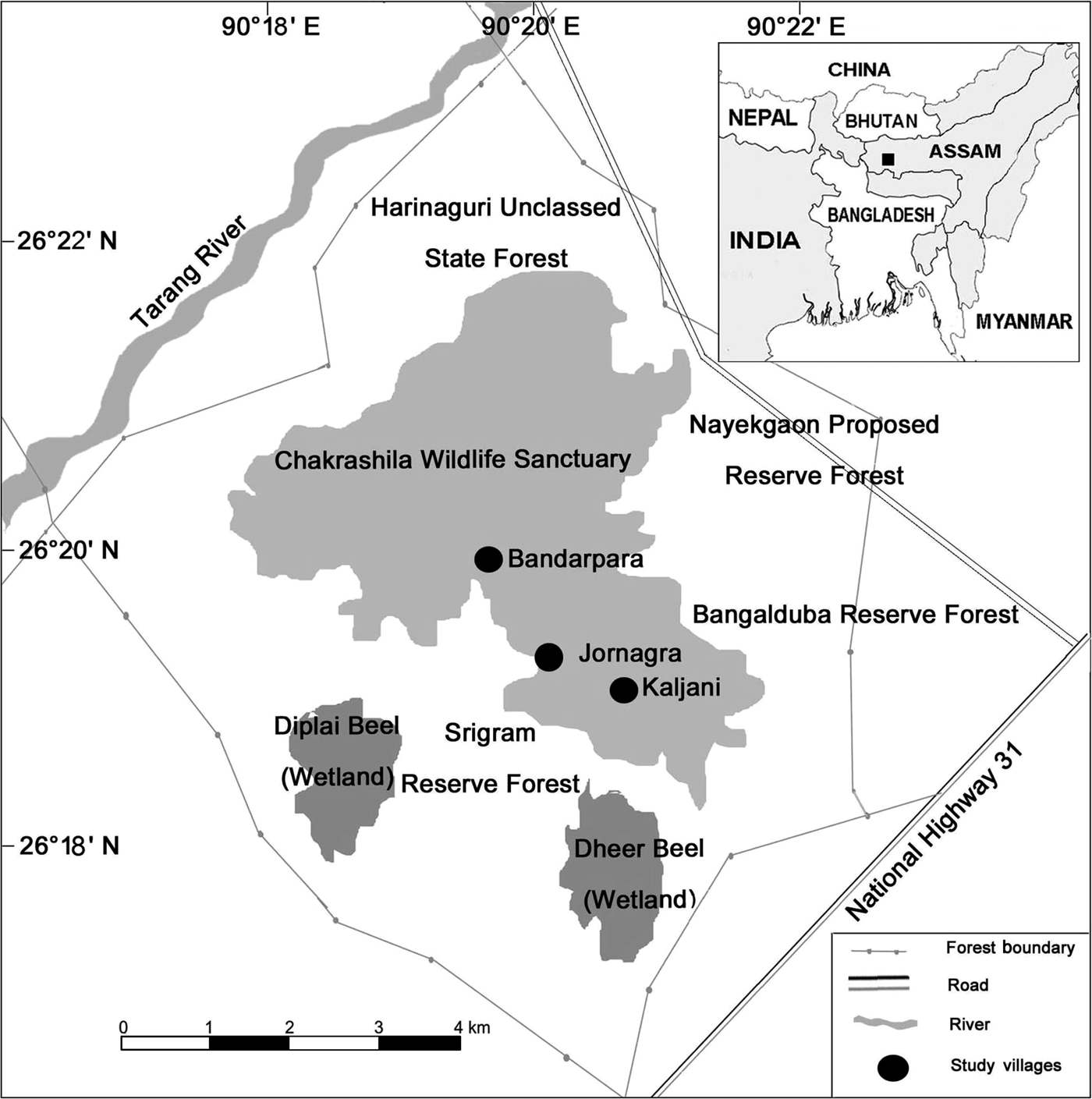
Fig. 1 Location of the study villages in Chakrashila Wildlife Sanctuary, Assam, India.
The study focused on three villages in the vicinity of Chakrashila Wildlife Sanctuary: Jornagra (inhabited by the Rabha community), Bandarpara (inhabited by the Bodo) and Kaljani (inhabited by the Rajbongshi). Bandarpara is located c. 1 km from the forested areas of the Sanctuary, Jornagra c. 3–4 km and Kaljani c. 5–6 km. The three communities grow crops such as paddy, mustard and various vegetables, and rear poultry, goats, pigs and cattle, both for self-consumption and trade.
Methods
Preliminary surveys were conducted in 2010 and were followed by collection of detailed information, including about local culture and traditional customs, during 2011–2013, when ST lived in Jornagra. Research was conducted using a mixed-method approach (Ogra, Reference Ogra2009) to collect both qualitative and quantitative data. Quantitative data were collected during interviews using structured (open- and closed-ended questions) and semi-structured questions (Udaya Sekhar, Reference Udaya Sekhar2003; Ogra, Reference Ogra2009; Torri, Reference Torri2010; Ebua et al., Reference Ebua, Agwafo and Fonkwo2011), and qualitative data were collected through a focus group discussion and participatory rural appraisal (Bernard, Reference Bernard2002; Bajracharya et al., Reference Bajracharya, Furley and Newton2006; Kalibo & Medley, Reference Kalibo and Medley2007). The thematic coding approach was used in qualitative analysis, grouping the data into common categories or themes prior to analysis (Bernard, Reference Bernard2002). The participatory rural appraisal comprised informal discussions to elicit an oral history of the study sites and local people's involvement in the wildlife sanctuary movement, resource availability in the Chakrashila landscape, including the availability of wild animals and plants, resources extracted before and after the protected area was designated, and crop landraces (i.e. local varieties) cultivated. Transect surveys were conducted on foot with at least one local plant expert and one interpreter, to learn about local perspectives on the status and distribution of various forest resources. Prior informed consent was obtained from all interviewees and all participants in the focus group discussion and participatory rural appraisal. Secondary data on demography and forest-related matters, including documents and maps, were collected from the Block Development Office of Kokrajhar district and the Circle Office of Dhubri district of the Government of Assam.
Respondents were selected using stratified random sampling as well as purposive sampling methods. Fifty percent of households were selected at random from each of the three villages (Sah & Heinen, Reference Sah and Heinen2001), and the head of each household (regardless of gender) was asked fixed-response (Badola, Reference Badola1998) as well as open-ended questions (Shibia, Reference Shibia2010). Responses to questions about attitudes and perceptions were scored on a five-point Likert scale (1 = strongly agree; 2 = agree; 3 = neither agree nor disagree; 4 = disagree; 5 = strongly disagree; Likert, Reference Likert and Maranell1974). Thirty-seven, 17 and 15 respondents from Jornagra, Bandarpara and Kaljani, respectively, were interviewed. In addition, some key informants were selected by purposive sampling to participate in a focus group discussion. These included headmen, older knowledgeable residents, practitioners of traditional herbal medicine, people involved in conducting land measurements and fixing village boundaries, and frequent visitors to the forest. Interviews were conducted in Assamese, in which all the respondents were conversant, and local interpreters were present to help if an interviewee or the researcher did not properly understand a question or statement (Ogra, Reference Ogra2009). The names of plants and animals were also cross-checked and verified with the help of the interpreters. Quantitative data were analysed using SPSS 20 (IBM, Armonk, USA). Non-parametric Kruskal–Wallis and Mann–Whitney tests were used to check the significance of differences among data.
Results
Socio-economic profiles of Jornagra, Bandarpara and Kaljani villages
The respondents in Jornagra, Bandarpara and Kaljani did not differ significantly in terms of most of the socio-economic variables assessed, such as age, family size, land holding size, and crop production (Table 1). They also had similar literacy status. However, primary income (i.e. income from the main livelihood option on which a household depends) was significantly higher among respondents from Jornagra compared with those from Kaljani, although the differences between Jornagra and Bandarpara, and Bandarpara and Kaljani were not significant. In terms of secondary income (i.e. income from supplementary sources, or substitute income on which households depend during periods when the primary income source is unavailable or inadequate) there was no significant difference among the three villages. Jornagra residents grew several paddy varieties that included several landraces, whereas Bandarpara and Kaljani residents grew only one or two varieties (Table 1). Jornagra residents used split banana trunks to transport water for irrigating their paddy fields and were not entirely dependent on rainwater for agriculture. In Kaljani prolonged inundation of agricultural land by flood waters from nearby wetlands posed constraints on agriculture. Chemical fertilizers and pesticides were used mostly in Jornagra.
Table 1 Socio-economic profile of study participants in Jornagra, Bandarpara and Kaljani villages in Chakrashila Wildlife Sanctuary, Assam, India (Fig. 1). Different superscripts indicate significant differences (P ≤ 0.05: Mann–Whitney test) between values (mean ± SD) in a given row.
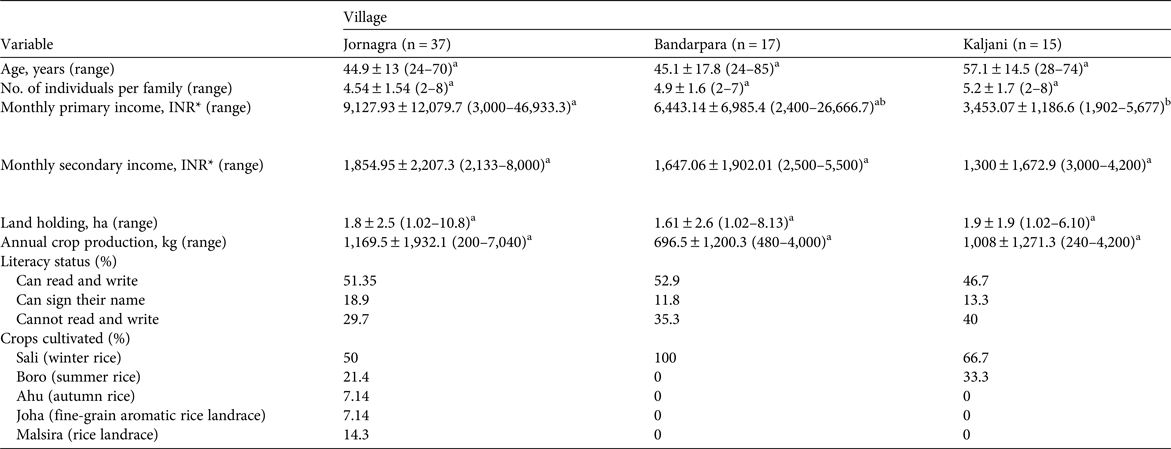
*USD 1 = c. INR 66
Community attitudes and perceptions
In Bandarpara and Jornagra the availability of forest products was identified as the highest priority for maintaining Chakrashila as a protected area (76.47 and 54.05%, respectively), followed by biodiversity conservation (23.53 and 45.95%, respectively). In Kaljani 53.33% of respondents identified biodiversity conservation as the highest priority, followed by forest products (46.67%). Aesthetic beauty was the third most important priority in all three villages, and availability of medicinal plants was the fourth. The respondents’ opinions and perceptions of conservation-related issues in the wildlife sanctuary (summarized in Table 2) reveal that c. 75–89% of the respondents from the three villages were supportive of the government's efforts to protect forest and wildlife through legislation. Circa 93–100% also believed that people and wildlife could coexist in the sanctuary area. The duration of residence was not an important factor in these villages, as almost all the respondents were born in the villages, and those who had migrated belonged to the resident community of the village, and had therefore integrated into the cultural–religious milieu. In terms of frequency of forest visits (Table 3) the percentage of respondents making weekly visits was highest in Bandarpara (88.24%), followed by those from Jornagra (43.24%) and Kaljani (13.33%), reflecting the influence of proximity to the forest. Over 70% of respondents from Bandarpara and Kaljani, and 40% of those from Jornagra, did not perceive any noticeable increase in forest cover after the area was designated a protected area. Circa 30–40% of the respondents from the three communities thought that forest management was satisfactory, although 23–53% did not think so. Among the Bandarpara respondents, 64.7% did not have a cordial relationship with the forest staff; the percentages for Jornagra and Kaljani were c. 35 and 20%, respectively. It is possible that the residents of Bandarpara appreciated the role of the forest staff in preventing poachers and tree-fellers but also expected to have special privileges as forest-dwellers (to be allowed to collect non-timber forest products at a subsistence level), which the forest staff did not allow. Thus the Bodo community, which lived closest to the forest, was largely unhappy with the overall management of the forest, the conflict arising mainly over access to forest products. Regarding human–wildlife conflict and related issues (Table 4), c. 58–65% of the respondents in the three villages perceived a decrease in the number of wild animals since the area was designated a wildlife sanctuary in 1994, and c. 16–26% perceived an increase. All respondents in all three villages wanted to conserve the golden langur, primarily because of its beauty and because it did not cause damage, followed by its value as a tourist attraction and its importance as the basis for the wildlife sanctuary designation. In contrast, c. 72–76% of the Jornagra and Bandarpara respondents identified the rhesus macaque Macaca mulatta as a cause of damage to paddy and fruit crops, followed by birds (21–23%), the barking deer Muntiacus muntjak and field rats Rattus spp. (2.7% each). In Kaljani 20 and 33.3% of the respondents disliked the rhesus macaque and birds, respectively, whereas c. 46% did not have a negative attitude towards any wildlife. Perception of crop damage was highest in Jornagra, followed by Bandarpara and Kaljani. Circa 78–86% of the respondents in the three villages identified scarcity of food and water as the primary reason for wild animals straying into human habitations. Translocation of the rhesus macaque to other areas was the most widely suggested potential measure to reduce human–wildlife conflict in Jornagra, followed by monetary compensation, whereas the reverse was the case in Bandarpara and Kaljani, although 17.7% of respondents in Bandarpara thought that deploying more forest guards would help.
Table 2 Perceptions of conservation-related issues by respondents in Jornagra (n = 37), Bandarpara (n = 17) and Kaljani (n = 15) villages in Chakrashila Wildlife Sanctuary (Fig. 1), based on statements scored on a Likert scale.
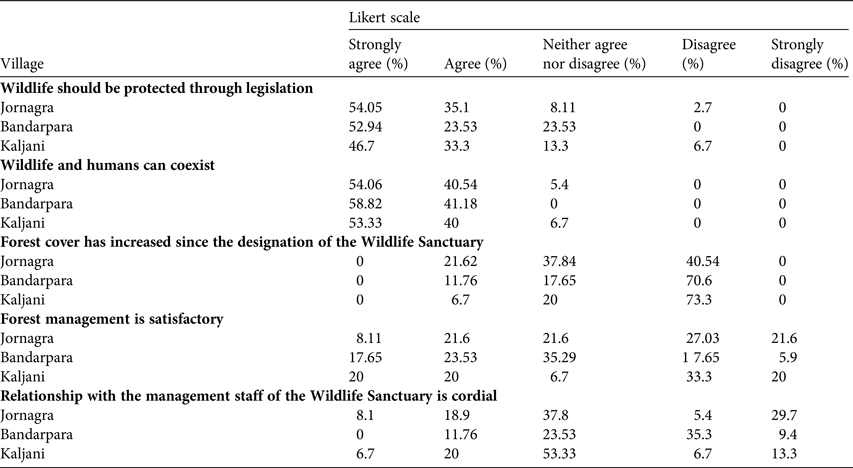
Table 3 Frequency of forest visits by respondents in Jornagra, Bandarpara and Kaljani villages in Chakrashila Wildlife Sanctuary (Fig. 1).
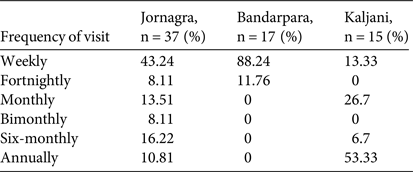
Table 4 Perceptions of human–animal conflict and related issues by respondents in Jornagra, Bandarpara and Kaljani villages in Chakrashila Wildlife Sanctuary (Fig. 1).
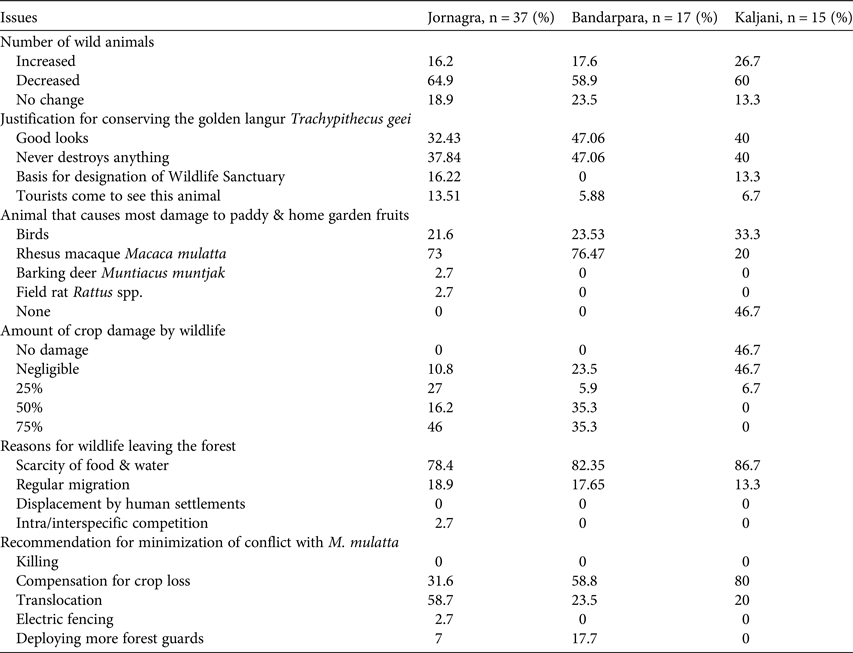
Taboos on resource use
Taboos on resource use (Table 5) observed by the three communities were specific to their gotras (clans). The Rabha and Rajbongshi communities never consumed the species with which their gotras were identified, and also observed some restrictions on plant use. Likewise, the Bodo community followed taboos that were related to family names.
Table 5 Taboos on forest resource use by various gotras (clans) of the Rabha, Bodo and Rajbongshi communities.
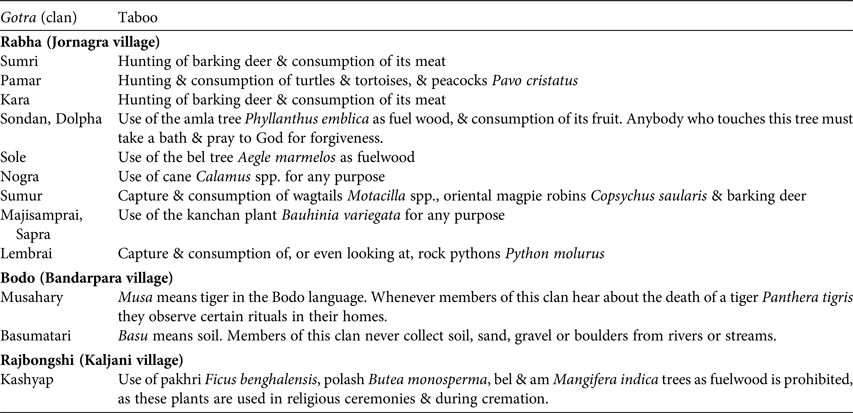
Sacred groves
Jornagra is surrounded by hills, such as Belguri, Manshikata Badha, Udalguri, Khejurguri, Haldibari, Sirakhowa, Shingimari, Bamunisura and Bagher khoj. Patches of forest on Belguri are sacred sites, and the Bamunthakur (Shiva) Temple is found at one such site. Hills near Bandarpara include Daoshinsari, Gatoibari, Antaidular, Bogasil, Badhuwa Pahar, Boglaguri Pahar, Barnangnai and Doisagaran. Deities are believed to reside in nature on Petpakhra (a local deity) and Dholashil (white rock) sacred groves, which are known locally as than. These groves cover c. 14 ha in total. There is a sacred 4–5 ha grove near Kaljani, called Lengtiya Pahar Santijog Shivashram (Shiva temple). The dominant plant species in these groves are Terminalia bellerica, Lannea coromandelica, Shorea robusta, Cassia fistula, Toona ciliata, Bursera serrata, Aegle marmelos, Albizia procera, Terminalia chebula, Sterculia villosa, Tectona grandis, Azadirachta indica, Phyllanthus emblica, Lagerstroemia flos-reginae and Stereospermum personatum.
Discussion
The socio-economic conditions of the three communities did not differ significantly, although the primary income of the Rabhas of Jornagra was higher because of their indigenous irrigation system, which facilitated cultivation of alternative varieties of paddy, and higher productivity.
The majority (c. 75–89%) of the respondents from the three communities supported the designation of Chakrashila as a protected area, with residents of Bandarpara being the most concerned about the availability of forest products, followed by Jornagra, probably reflecting their proximity to the forest. In contrast, more respondents from Kaljani (Rajbongshi), which is located furthest from the forest, prioritized biodiversity conservation, followed by forest products. Similarly, in Bangladesh farmers living away from the forest were found to be more supportive of conservation (Sarker & Røskaft, Reference Sarker and Røskaft2011). However, in the Bangladesh study affluent respondents favoured conservation more than the poor, which was not observed in our study. The proximity of Bandarpara to the forest and the prioritization of forest products by its residents may also be linked to their antagonism towards forest officials, who try to restrict or regulate their entry into the forest for collection of forest products. Nevertheless, besides the importance of forests for their livelihoods, members of the three communities also attached high priority to biodiversity conservation and the aesthetic beauty of the forest. Most respondents believed that wildlife and people could coexist in this area, and although they had an antagonistic attitude towards the rhesus macaque because of its crop-raiding and other disruptive habits, they were averse to killing it. The women of Jornagra and Bandarpara were particularly antagonistic towards the rhesus macaque because when the men went to the market on Sundays and Wednesdays the women and children had to guard the crop fields, which disturbed their household chores and disrupted the children's education. The government's compensation policy covered crop damage by elephants but did not compensate for economic losses resulting from crop-raiding macaques, which was a matter of concern for the residents of Jornagra and Bandarpara. However, most respondents from Kaljani did not have negative attitudes towards any wildlife. It is known that monetary losses can make communities antagonistic and intolerant towards wildlife (Nyhus et al., Reference Nyhus, Tilson and Sumianto2000) and that crop fields bordering forests experience more crop raiding (Jhala, Reference Jhala1993; Studsrød & Wegge, Reference Studsrød and Wegge1995; Udaya Sekhar, Reference Udaya Sekhar1998; Hoare & du Toit, Reference Hoare and du Toit1999; Hill, Reference Hill2000; Saj et al., Reference Saj, Sicotte and Paterson2001). In Chakrashila all three communities were favourably disposed towards the golden langur for its harmless nature and beauty. It is also sacred to the Rabha and Bodo communities, the latter believing it to be the descendant of the mythical king of monkeys, which contributes to its iconic status. This positive attitude provided a sound basis for the success of Chakrashila as a protected area. However, the forest residents also felt that they had few options, as they did not possess any land elsewhere, nor were they sufficiently skilled or educated to pursue an alternative livelihood elsewhere. Many pepole, especially the elderly, cherished their generations-old link with the forest and did not feel at home outside it. Udaya Sekhar (Reference Udaya Sekhar2003) noted that benefits obtained by local people from wildlife tourism and other related sources in the Sariska Tiger Reserve, India, were sufficient for them to ignore the losses or inconveniences suffered as a result of depredation by wildlife and restricted access to forest resources. Although wildlife tourism at Chakrashila is at a nascent stage, local people have begun to accrue some benefits after being trained by the NGO Nature's Beckon to work as cooks or guides.
As part of their cultural practices and religious beliefs the three communities maintained sacred groves that harboured several plant species valued for their timber as well as for medicinal and magico-religious purposes. Many of these plants are also protected under the clan (gotra) taboos. Informally protected areas such as sacred groves are as important as formal ones because they harbour a rich diversity of plants and animals (Bhagwat et al., Reference Bhagwat, Kushalappa, Williams and Brown2005). Taboos are relatively more elaborate in the case of the Rabhas but are also prevalent among the other two communities. Although the area came under government protection only recently, it had been maintained in a relatively pristine condition through the traditional conservation-oriented practices of the communities. This is perhaps one of the reasons that during the focus group discussions many respondents from the communities expressed more faith in community-based conservation than in governmental initiatives to protect the Chakrashila area. This type of conservation has been shown to be effective for wildlife and plants restricted to the sacred groves of India's Western Ghats (Bhagwat et al., Reference Bhagwat, Kushalappa, Williams and Brown2005). In the Chakrashila area a number of plants (e.g. P. emblica, A. marmelos, Calamus spp., Bauhinia variegata, Ficus benghalensis, Butea monosperma and Mangifera indica) are not used as fuelwood by specific clans, thus conserving these resources for other purposes, such as medicinal (Talukdar & Gupta, Reference Talukdar and Gupta2014) and magico-religious use. Similar abstinence from using certain totemic plants and animals was encountered among several tribes of West Bengal (Deb & Malhotra, Reference Deb and Malhotra2001). Furthermore, incidences of hunting of taboo animals, such as leopards Panthera pardus, deer, pythons Python molurus, turtles (mostly Nilssonia spp. and Lissemys punctata andersoni) and certain birds, are unknown in this area. The practice of wrapping a piece of red cloth around F. benghalensis and sticking a trident into the ground under A. marmelos trees appeared to protect them from being felled, as indicated by their larger girths compared to trees found in other parts of the forest. This is similar to the protective dapo symbol placed at the entrance of forests protected under customary law in Arunachal Pradesh (Dollo et al., Reference Dollo, Gopi, Teegalapalli and Mazumdar2010). In a review of the role of Indian sacred groves Ormsby & Bhagwat (Reference Ormsby and Bhagwat2010) observed that the original deities of these groves became transformed into mainstream gods and goddesses. Transformation and absorption into the Hindu pantheon could be said to have occurred in Chakrashila also, as exemplified by the existence of several Shiva temples in the forest, and the merging of Bodo ancestor worship (obonglaoree) into Shiva worship. However, this does not appear to have diminished the zeal with which these sacred forest patches have been protected by successive generations of these communities. Thus a mutual exchange and enrichment of world views can be said to have occurred, with the nature-centric aspects of the worship of animist deities influencing Hindu religious beliefs and rendering them more environmentally benign.
Set amidst the densely populated districts of Dhubri and Kokrajhar (1,171 and 280 people km−2, respectively), Chakrashila Wildlife Sanctuary is an island of biodiversity, > 120 km from the nearest biodiversity-rich area of Manas National Park. Such small reserves are negatively affected by human interference (Lindenmayer & Franklin, Reference Lindenmayer and Franklin2003). The establishment of a wildlife sanctuary at Chakrashila was made possible by a popular movement involving the local people, spearheaded by the NGO Nature's Beckon. Community support, cooperation and vigilance are essential for protecting and sustaining the integrity of this sanctuary. Our findings indicate that besides ensuring the livelihood security of the local communities, it is equally necessary to take into account their cultural–religious ties with the forest, and encourage them to perpetuate these ecocentric ethical perceptions in their world views and attitudes.
However, gauging the perceptions of the communities is a challenging task, as respondents may be guarded or mask their actual views with those held by the majority of their community. The gap between the perceptions of the interviewer and interviewee is also an important factor. Despite these limitations, our findings indicate a number of trends. Firstly, the respondents from all three communities admitted that their livelihood skills did not meet the requirements for a successful urban or even a rural living away from the forest. However, their material dependence on the forest for its resources only partly explained their attitudes towards it, and especially its wildlife. For instance, even though the rhesus macaque damaged their crops and disturbed the normal rhythms of the lives of women and children, respondents were almost unanimously against killing these animals. They regarded the golden langur as a divine animal, and had totem plants and animals, which they protected in their everyday activities. Their ancestor worship is also intimately associated with the forest through the totem organisms, and various rites and rituals. Our findings show the importance of cultural–religious factors in governing the attitudes of these tribes to the forest, and any successful conservation strategy in such an area, surrounded by indigenous communities, would have to take these factors into account rather than dismissing them as less important than more resource-oriented considerations. This study emphasizes the need to address issues such as empowerment of indigenous communities, and ensure their participation in the conservation process in a more locale- or community-specific manner. The concept of community empowerment must transcend the practice of merely providing some preconceived livelihood packages, which may not only be unsuitable or unacceptable but also lead to increasing indifference, especially among the younger generation, towards the indigenous, tradition-derived mechanisms for conserving their surroundings. The significance of cultural values in conservation has been widely recognized but these values must be integrated into conservation programmes in protected areas with indigenous communities within or close to their boundaries. Incentives for ensuring conservation ought to include support for better maintenance of sacred groves, preservation and propagation of nature-oriented folklores and other cultural elements, and strengthening of traditional institutions, instead of ignoring and disempowering them and concentrating merely on granting economic packages.
Acknowledgements
ST expresses her gratitude to the Department of Science and Technology, New Delhi, for its financial support through the INSPIRE Fellowship. We thank Dr Ananta Borah of Birjhora Mahavidyalaya for plant identification; the Forest Department of the Government of Assam; Nature's Beckon and its Director Soumyadeep Datta; Someshwar Rabha, the headman of Jornagra village; local guides Durga Rabha, Gala Basumatary and Kharam Rabha; and other members of the Jornagra, Bandarpara and Kaljani communities who gave invaluable help and support during data collection.
Author contributions
ST conducted the field study and collected quantitative and qualitative data, and wrote the first draft of the article. AG drafted the interview schedule and prepared the final version of the article.
Biographical sketches
Simi Talukdar’s research is focused on community-based conservation, resource utilization patterns of indigenous communities, and their attitude towards forest and wildlife conservation, in western Assam, India. Abhik Gupta’s research interests include environmental ethics and history, and nature–culture interactions.










